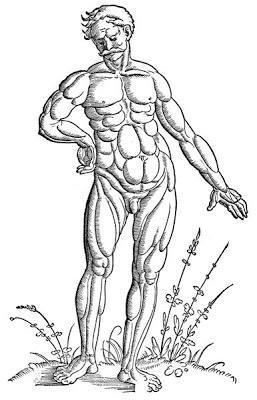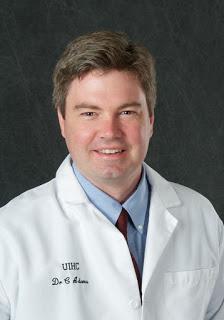
Muscle Man Standing by Hans Baldung
Although we haven't heard from Dr. Brad Gibson lately, he is still consulting with me behind the scenes and also gives me a heads up when he comes across some information he thinks we might want to share with you. And recently when his colleague Dr. Chris Adams, who is a medical researcher studying muscle aging and sarcopenia, was in town, Brad arranged for me to meet Chris because he knew I'd be very interested in the work that Chris is doing. And I was! But I was very good and didn't pester Chris too much over our dinner, but instead approached him afterward to see if he would let me officially interview him. The result is this post today! Thank you so much, Chris, for taking the time out of your busy schedule to educate us all on this important topic. (By the way, Chris says that although he doesn't do yoga, his wife does. And he's becoming aware that he himself needs to start.)Nina: Let’s start by having you address what sarcopenia is. We here at YFHA understand that muscles change as we age, losing mass and density in everyone to some extent. Is sarcopenia the name of this natural process? Or is sarcopenia the disease stage of this process, the way osteopenia is the disease stage of natural bone loss associated with aging?
Chris: In general, sarcopenia is a condition of being of advanced age and having an amount of skeletal muscle mass that is significantly lower than the average muscle mass of the general population. However, there are several competing definitions of sarcopenia, and, at this point, there is no general agreement on how to specifically define lower than average muscle mass in older people. In addition, comparing an older individual's muscle mass to the general population can be misleading. Because people come in many shapes and sizes, the amount of muscle mass varies widely from individual to individual. Also, as you noted, we all lose muscle mass to some degree as we age. An older person who was very muscular as a younger adult may have experienced quite significant muscle loss with age, even though their muscle mass as an older adult appears normal relative to the general population.
In addition to underestimating the number of people who have lost muscle mass with age, sarcopenia does not consider the most important aspect of muscle aging, the loss of strength. Between the ages of 30 and 40, nearly all people, even elite athletes, begin to experience a loss of muscle strength. Over the following decades, strength continues to erode while muscle mass typically declines to a lesser degree. As a result, reduced muscle quality (i.e., strength per unit muscle mass) is a hallmark of the aging process. By the age of 70, almost everyone will report that they are not as strong and probably not as muscular as when they were 25 years old.
The most important question for older people is not whether their muscle mass is lower than the general population, but whether they remain strong enough to accomplish the physical tasks that they wish to accomplish. Fortunately, the field of muscle aging seems to be moving away from strict considerations of muscle mass and moving towards a greater focus on muscle quality and functional outcomes. I think this transformation will be necessary before muscle aging is able to take its place in the mainstream of medical practice. Right now, muscle aging is scarcely addressed by the medical community.
Compared to the field of muscle aging, the field of bone aging is much more advanced in every way, and in contrast to the term sarcopenia, the term osteopenia is very useful. Osteopenia and its more severe form, osteoporosis, describe well-defined stages in a disease process, can be easily diagnosed, and have real prognostic value, or, in other words, they are clearly associated with clinically meaningful outcome, fracture. It is also worth noting that the definitions osteopenia and osteoporosis are based on the strength of bone (bone density) rather than the amount of bone, which, like the amount of muscle, can vary widely from person to person and is rather beside the point.
Nina: Is there a theory of why this happens?Chris: Yes. The fundamental underlying process in muscle aging is called skeletal muscle atrophy. In skeletal muscle atrophy, skeletal muscle cells, or muscle fibers, become smaller and weaker, leading to a loss of muscle mass, quality, and strength. Skeletal muscle atrophy can be generalized (affecting most or all of the muscles in the body) or it can be localized (affecting only one or a few muscles in the body). Aging typically promotes generalized skeletal muscle atrophy.
It is important to know that skeletal muscle atrophy can be caused by many things in addition to aging. Other common causes of skeletal muscle atrophy include malnutrition, muscle disuse (e.g., sedentary lifestyle, bed rest, orthopedic injuries, osteoarthritis, stroke, spinal cord injury, and other neurologic disorders), certain illnesses (e.g., cancer, diabetes and several other endocrine disorders, heart failure, COPD, kidney failure, cirrhosis, rheumatoid arthritis, critical illness, and chronic infections such as HIV/AIDS) and certain medications (e.g., prednisone, cancer chemotherapy, and hormonal prostate cancer treatments). If a person develops a condition that causes skeletal muscle atrophy, then that condition will accentuate the loss of muscle mass, quality, and strength during aging.
At the molecular level, muscle aging is still poorly understood. The molecular mechanisms are no doubt complex, and they are difficult to study because they occur so slowly. In all likelihood, muscle aging reflects an accumulation of small molecular changes in skeletal muscle that persist over many years. We and others are working to understand how aging affects skeletal muscle at the molecular level, and our laboratory recently discovered the first example of a protein that is required for the loss of muscle mass, quality and strength during aging. The protein is called ATF4, and it is a transcription factor that alters skeletal muscle gene expression in a manner that causes muscle atrophy. This finding of ATF4 provides an important clue that should help us uncover other molecular aspects of muscle aging over the next few years.
Nina: You told me earlier that there is a great variation in the way individuals lose muscle mass, depending on their body types, and so on. Could you briefly explain that?Chris: Variability in muscle mass and strength in older individuals is at least partially explained by genetic, environmental, and behavioral factors that determine: 1) the amount of peak, or young adult, muscle mass and strength, and 2) the absence or presence of other causes of skeletal muscle atrophy. There may also be genetic variability in the rate at which proteins such as ATF4 reduce muscle mass and strength during aging, but that is speculative at this point.
Nina: Are there effective interventions for halting or slowing the progression of muscle loss?
Chris: Unfortunately, at this point, there are no available interventions for halting or slowing muscle aging, and a medicine for skeletal muscle atrophy does not yet exist. However, a healthy lifestyle can significantly reduce a person's risk for developing additional causes of skeletal muscle atrophy. For example, exercises such as yoga prevent muscle disuse, a very potent cause of skeletal muscle atrophy.
Nina: How effective is target muscle building in the presence of muscle loss?
Chris: It can be very effective, especially when we are younger. It becomes more difficult to rebuild muscle as we grow older.
Nina: For people who are aging, what would you recommend as the best ways to maintain muscle strength as we age?
Chris: At this point, the recommendations are pretty general and would consist of: 1) maintaining a healthy diet, 2) resistance exercise, such as yoga or weight lifting, assuming there is no medical contraindication to exercise, and 3) avoiding preventable or treatable risk factors for other conditions that cause skeletal muscle atrophy, such as smoking, alcoholism, hypertension, obesity, high LDL cholesterol, etc.
There is a large unmet need for more specific recommendations, and scientists such as Blake Rasmussen at University of Texas-Galveston are doing some very nice and important work to develop specific exercise recommendations for older people, as well specific dietary recommendations, particularly for protein intake, which is especially important for muscle health. In addition to that work, we and others are working to develop nutritional products that are enriched in dietary compounds that help maintain muscle mass and strength during aging. For example, our laboratory recently discovered two natural compounds that reduce ATF4 activity in skeletal muscle of elderly mice, leading to increased muscle mass, quality and strength. One of those compounds, called ursolic acid, is naturally found in apples and several other edible fruits and herbs. The other natural compound, called tomatidine, is a metabolite of a compound that is found in tomatoes, especially unripe, green tomatoes. We are optimistic that compounds such as ursolic acid and tomatidine will someday form the basis for specially designed foods that help promote healthy aging. In addition, we are hopeful that compounds such as these will lead us to medicines that can halt or reverse the effects of muscle aging.
Nina: Besides our muscles getting weaker as we age, they also get stiffer. Is this increasing stiffness due to the same changes that make our muscles weaker?Chris: That's a very interesting question. To my knowledge, the answer is unknown. I am also not aware of any ongoing research in this area, but it is certainly an important issue, and it would be a great area for research.
Nina: In our previous conversation, you said to me about bones something that I didn’t know, which is that bones age in a similar way to muscles in everyone (not just in people who are prone to develop the “disease” osteoporosis). Can you say a bit more about that? And what is the relationship between the changes in the muscles and the changes in bones that result from aging?
Chris: In most circumstances, muscle and bone go hand-in-hand. Muscle strength and bone strength require similar nutrition and exercise, and both are weakened by poor nutrition, disuse, serious illness, and aging.
Nina: Should that information about the connection between aging of muscles and bones affect our thinking about how to maintain both muscle and bone strength as we age?
Chris: Yes, a healthy lifestyle that includes exercises such as yoga can be beneficial for the strength of both muscle and bone.
Subscribe to Yoga for Healthy Aging by Email ° Follow Yoga for Healthy Aging on Facebook ° Join this site with Google Friend Connect

